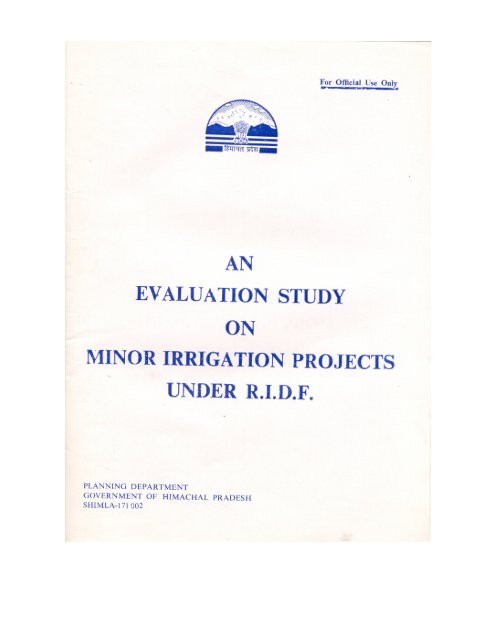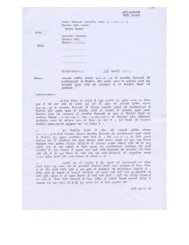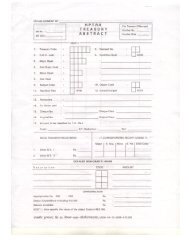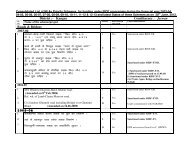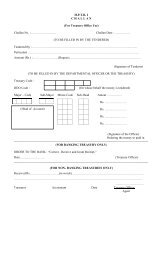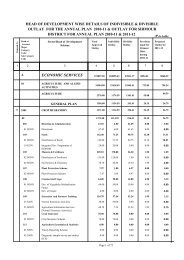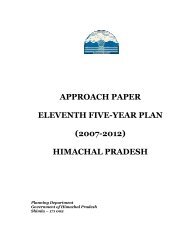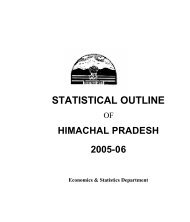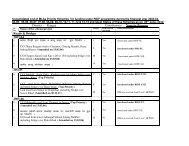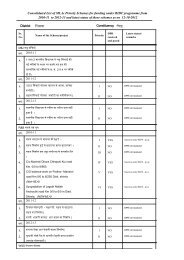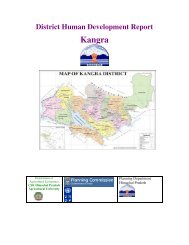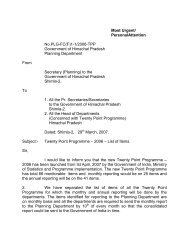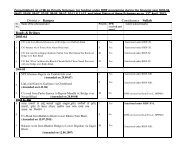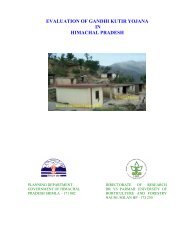Minor Irrigation projects under RIDF - Planning Department ...
Minor Irrigation projects under RIDF - Planning Department ...
Minor Irrigation projects under RIDF - Planning Department ...
Create successful ePaper yourself
Turn your PDF publications into a flip-book with our unique Google optimized e-Paper software.
CHAPTER-1<br />
INTRODUCTORY<br />
1.1.1 Eighth Five Year Plan period witnessed a deceleration in public sector<br />
investment in agriculture and rural infrastructure development. One of the basic limitations to<br />
develop rural infrastructure was lack of resources. State Governments which needed to develop<br />
and maintain rural infrastructure were experiencing severe resource crunch. This apart, the<br />
commercial banks which were to channelise atleast 18 percent of their total lending to<br />
agriculture were unable to fulfil their commitments. In this background, the Hon'ble Finance<br />
Minister while presenting the Union Budget for 1995-96 on 15th March,1995 had inter- alia<br />
indicated:<br />
" Inadequacy of public investment in agriculture is today a matter of general concern.<br />
This is an area which is the responsibility of the States but many States have neglected<br />
investments in infrastructure for agriculture. There are many rural infrastructure <strong>projects</strong><br />
which have been started but are lying incomplete for want of resources. They represent major<br />
loss of potential income and employment to the rural population."<br />
1.1.2 In order to hasten the process for the completion of <strong>projects</strong> Union Finance Minister<br />
had indicated setting up of Rural Infrastructure Development Fund (<strong>RIDF</strong>) in NABARD from<br />
April, 1995. Initially Rural Infrastructure Development Fund (<strong>RIDF</strong>) was created with a corpus<br />
of Rs.2,000 crores.<br />
2. Main Features:<br />
1.2. Contributions to <strong>RIDF</strong>:<br />
The contributions to R.I.D.F were to be received from scheduled commercial banks,<br />
excluding foreign banks, operating in India, to the extent of shortfall in agricultural lending in<br />
the priority sector target, subject to a maximum of 1.5 percent of the net bank credit. Since then,<br />
the scheme has been continued with the announcements in the successive Union Budgets with<br />
enhanced committed contributions of Rs.2500 crore, Rs. 2500 crore, Rs.3000 crore and Rs.<br />
3500 crore for the years 1996-97, 1997-98, 1998-99 and 1999-2000 as <strong>RIDF</strong>-II, <strong>RIDF</strong>-III, <strong>RIDF</strong>-<br />
IV and <strong>RIDF</strong>-V respectively. By 1999-2000, such committed contributions aggregated to Rs.<br />
13,500 crore. The tenure of such contribution to the fund was 5 years which has been<br />
increased to 7 years <strong>under</strong> <strong>RIDF</strong>-V.<br />
1.3 Eligible Purposes:<br />
1.3.1 Under <strong>RIDF</strong>-I, incomplete or on-going <strong>projects</strong> in minor, medium and major irrigation<br />
alongwith <strong>projects</strong> in flood protection, watershed management and soil conservation were<br />
accorded priority. Projects on rural roads and bridges for connecting rural areas with<br />
urban marketing centres / highways / rail heads and facilitating inter-connectivity of villages<br />
became a major component for support <strong>under</strong> <strong>RIDF</strong>-II and thereafter. Development<br />
of integrated market yards, modernisation of existing inland waterways for transportation of<br />
agricultural produce were also made eligible purposes <strong>under</strong> <strong>RIDF</strong>-II.<br />
1.3.2 Projects relating to (a) harvesting of rain water to reduce the runoff and salinity<br />
ingression in coastal areas, (b) irrigation <strong>projects</strong> that were already completed and not
operationalised and could be made functional after some renovation and (c) construction of<br />
terminal and rural markets to facilitate marketing of agriculture and horticulture produce were<br />
also considered as eligible for support since <strong>RIDF</strong>-III.<br />
1.3.3 Under <strong>RIDF</strong>-IV, <strong>projects</strong> relating to construction of fish jetties have been included in the<br />
existing purposes. Under <strong>RIDF</strong>-V, primary school buildings, rural drinking water works, drainage,<br />
primary health centres, village haats, forest development etc. have also been made eligible if<br />
they are taken up by Panchayati Raj Institutions, Self Help Groups, Non-<br />
Governmental Organizations etc.<br />
1.4 Rates of Interest:<br />
On the contributions to the Fund, NABARD pays interest @ 11.5% p.a. (12.5% in <strong>RIDF</strong>)<br />
to commercial banks and on loans out of this Fund, it receives an interest of 12% p.a. (13% in<br />
<strong>RIDF</strong>-I).<br />
3. Other Features:<br />
i) Under the first four tranches of <strong>RIDF</strong>, loans were advanced to State Governments and<br />
Government owned Corporations. In fifth tranch of <strong>RIDF</strong>, the scope of the Fund has<br />
also been extended to cover Gram Panchayats, Self Help Groups (SHGs) and<br />
Non- Governmental Organisations (NGOs).<br />
ii) All loans from the Fund are project based. The project proposals received from the State<br />
Government are appraised for technical feasibility, financial viability and economic benefit.<br />
iii) While ongoing incomplete <strong>projects</strong> were accorded priority <strong>under</strong> <strong>RIDF</strong>-I, new <strong>projects</strong><br />
have also been made eligible for support <strong>under</strong> the subsequent four tranches of the Fund.<br />
iv) Projects with shorter gestation period are given priority unde the <strong>RIDF</strong>. State<br />
Governments are required to complete the execution of the <strong>projects</strong> within a maximum<br />
period of three years.<br />
v) Under <strong>RIDF</strong>-V, the period of repayment has also been increased from 5 to 7 years.<br />
vi) Loans <strong>under</strong> <strong>RIDF</strong> are sanctioned by a Project Sanctioning Committee (PSC) which is a<br />
sub-committee of the Board of Directors of NABARD.<br />
vii) The implementation of <strong>projects</strong> sanctioned is subjected to close monitoring. For this<br />
purpose, a high powered committee chaired by Chief Secretary/Agriculture Production<br />
Commissioner is constituted. In West Bengal, the Finance Minister of State chairs some<br />
of the meetings. The committee ensures proper coordination among different<br />
implementing agencies of the State Government.<br />
viii) The progress in implementation is also assessed by NABARD through a set of specially<br />
designed formats and field visits. Periodical discussions are held with officials<br />
concerned of the State Governments to sort out identified problems.<br />
4. Projects Sanctioned to H.P:<br />
1.4.1 In so far as Himachal Pradesh is concerned <strong>RIDF</strong> assistance proved to be tremendously<br />
useful in the creation of rural infrastructure facilities viz. construction of Rural Roads, <strong>Minor</strong><br />
<strong>Irrigation</strong> schemes, Bridges and Primary School Buildings . The details of <strong>projects</strong> sanctioned<br />
<strong>under</strong> <strong>RIDF</strong>-I to VII alongwith the loan sanctioned by NABARD are depicted in the following<br />
table:-<br />
2
Table-1<br />
(Rs. in Lakh)<br />
Tranches of<br />
<strong>RIDF</strong><br />
Category of Projects<br />
No. of Projects<br />
Sanctioned<br />
Amount of Loan<br />
Sanctioned<br />
1. 2. 3. 4.<br />
I <strong>Minor</strong> <strong>Irrigation</strong> Projects 77 1422.71<br />
II 1.<strong>Minor</strong> <strong>Irrigation</strong> Projects 64 }<br />
} 5295.78<br />
2.Rural Roads 2 }<br />
III 1.<strong>Minor</strong> <strong>Irrigation</strong> Projects 18 }<br />
2.Rural Roads 8 } 5111.56<br />
3.Bridges 2 }<br />
IV 1.<strong>Minor</strong> <strong>Irrigation</strong> Projects 34 }<br />
2.Rural Roads 19 } 8858.03<br />
3.Bridges 14 }<br />
V. 1.<strong>Minor</strong> <strong>Irrigation</strong> Projects 44 }<br />
2.Rural Roads 22 }<br />
3.Bridges 7 } 11280.33<br />
4.<strong>Minor</strong> <strong>Irrigation</strong>(Agri.) 160 }<br />
5.Pry. School Buildings 500 }<br />
VI. 1.<strong>Minor</strong> <strong>Irrigation</strong> Projects 75 }<br />
2.Flow <strong>Irrigation</strong> Projects 168 }<br />
3.Rural Roads 30 } 13503.00<br />
4.Bridges 21 }<br />
5.Pry. School Buildings 984 }<br />
6.IT 1 }<br />
VII. 1.<strong>Minor</strong> <strong>Irrigation</strong> Projects 1 }<br />
2.Rural Roads 62 }<br />
3.Bridges 10 } 7748.88<br />
4.IWDP 133 }<br />
5.IT 1 }<br />
Total-I to VII 2457 53220.29<br />
1.4.2 The terms and conditions set for the availment of NABARD assistance provided<br />
that the nodal department for raising of demands for release of funds would be the Finance<br />
<strong>Department</strong> of State Government which in turn would establish satisfactory arrangements for<br />
channeling the funds to the concerned departments for executing the works but in the case of<br />
Himachal Pradesh, <strong>Planning</strong> <strong>Department</strong> of the State Government was declared as the nodal<br />
department keeping in view its past record in effective co-ordination and monitoring of similar<br />
<strong>projects</strong> year after year. With a view to evolve an effective mechanism for quarterly monitoring<br />
of the <strong>projects</strong> sanctioned <strong>under</strong> <strong>RIDF</strong> Programme, a High Powered Committee <strong>under</strong> the<br />
chairmanship of Chief Secretary, of the State Government was constituted. The Secretaries<br />
and Heads of the concerned departments were made members of this Committee.<br />
3
CHAPTER-II<br />
OBJECTIVES, METHODOLOGY AND SCOPE OF THE STUDY<br />
1. Objectives of the Study:<br />
During the course of seven years, 2457 <strong>projects</strong> of different categories viz<br />
.<strong>Minor</strong> <strong>Irrigation</strong>, Rural Roads, Bridges, Primary Education School Buildings etc. with an<br />
estimated cost of Rs. 532.20 crores were sanctioned to Himachal Pradesh. In 14th meeting of<br />
the High Powered Committee held <strong>under</strong> the chairmanship of Chief Secretary, Himachal<br />
Pradesh on 4 th July,2001, a decision was taken to conduct a quick evaluation study of<br />
the <strong>Minor</strong> <strong>Irrigation</strong> <strong>projects</strong> sanctioned <strong>under</strong> <strong>RIDF</strong>-I & II with an objective to make an<br />
assessment of the irrigation potential created and potential utilised by the benefitted farmers.<br />
2. Methodology:<br />
2.2.1 The data of <strong>projects</strong> completed was obtained from the <strong>RIDF</strong> Division of the <strong>Planning</strong><br />
<strong>Department</strong>. According to these details, 140 <strong>Irrigation</strong> works were sanctioned and completed<br />
<strong>under</strong> <strong>RIDF</strong>-I & II. All these <strong>projects</strong> constituted universe for the conduct of this study. Keeping<br />
in view the small size of the universe and time constraints, it was thought prudent to draw a<br />
small sample of the size of 5%. While applying stratified random sampling technique and making<br />
proportionate allocation to each stratum ( LIS, FIS and Tube-wells) 3 Lift <strong>Irrigation</strong><br />
Schemes, 1 Flow <strong>Irrigation</strong> Scheme and 3 Tube-wells were chosen for the conduct of this study<br />
covering all the 10 districts of the state.<br />
2.2.2 The secondary data was collected by Sh. S.L. Sharma, Deputy Director, Evaluation<br />
Division of the <strong>Planning</strong> <strong>Department</strong> who visited all the concerned S.E.s/ Executive Engineers in<br />
the selected area and collected the relevant data on the status of the Projects, List of<br />
Beneficiaries, functioning of the Water Users Associations/ Kisan Vikas Sanghs and Potential<br />
Created. During this tour, he also collected Primary Data on the schedules canvassed for the<br />
conduct of this study by holding interviews with members of the Kisan Vikas Sanghs and the<br />
beneficiaries. For selection of beneficiaries, judgement sampling method technique was used. It<br />
was also kept in view that atleast 5 percent beneficiaries of the selected <strong>projects</strong> were covered<br />
<strong>under</strong> the study.<br />
3. Scope and Coverage :<br />
After the implementation of <strong>RIDF</strong>-I & II, 140 <strong>Irrigation</strong> Projects ( 46 Lift <strong>Irrigation</strong><br />
Schemes, 20 Flow <strong>Irrigation</strong> Schemes and 74 Tubewells) pertaining to 10 non-tribal districts were<br />
completed by the end of March,1999. In order to draw a sample size of 5%, all category of<br />
schemes viz. LIS, FIS and Tubewells, were arranged stratum-wise and after consultation of<br />
relevant random number table, 7 schemes ( 3 LIS, 1 FIS and 3 T/Wells) pertaining to four districts<br />
namely Bilaspur, Mandi, Kangra and Una were chosen for the conduct of this study.<br />
4. Schedule:<br />
For field survey, a schedule as appended at Annexure “A” was canvassed which<br />
contained following information:-<br />
4
5. Field Work:<br />
1. Household data on the name, address, sex ,age, caste, occupation and size of<br />
landholdings of the beneficiaries.<br />
2. Details of existing irrigation sources.<br />
3. Land use pattern prior and after construction of the scheme.<br />
4. Details on the production of the important crops, before and after the<br />
construction of irrigation scheme.<br />
5. Details on the consumption of seeds, chemical fertilizers, manure and<br />
pesticides.<br />
6. Details on household income of the beneficiaries.<br />
7. Views of the beneficiaries about the functioning of the scheme.<br />
The concerned Executive Engineers of the I &PH <strong>Department</strong> were requested to<br />
ask all the beneficiaries as well as the members of the Water Users Associations/ Kisan Vikas<br />
Sanghs to be present on the spot at the time of the field visit of the Dy. Director, <strong>Planning</strong><br />
<strong>Department</strong>. Since, 5% beneficiaries were to be interviewed for the collection of primary data , the<br />
selection of the beneficiaries was made by judgement sampling method and keeping in view the<br />
local conditions of the area.<br />
6. Compilation and Analysis of the Data:<br />
The compilation of Primary and Secondary data was done by the Statistical<br />
Assistant of the Evaluation Division where as analysis and report writing was done by<br />
Sh. S.L. Sharma ,Deputy Director, <strong>Planning</strong> <strong>Department</strong>.<br />
7. Reference Period:<br />
The study covered two tranches of <strong>RIDF</strong>-I and <strong>RIDF</strong>-II, related to the year 1995-96<br />
to 1996-97 and schemes sanctioned there<strong>under</strong> and completed upto 31 st March,1999.<br />
5
CHAPTER-III<br />
ANALYSIS OF DATA<br />
3.1.1 To fulfil the outlined objectives of the study, data on the various aspects of schemes<br />
was collected by holding interviews with selected beneficiaries . Textual presentation of data<br />
collected from four districts <strong>under</strong> the study is given in the following tables:-<br />
2. Classification of Beneficiaries:<br />
3.2.1 The data collected on Sex and Age-wise classification of the beneficiaries is<br />
presented in the following table:-<br />
Category-wise Details<br />
of Schemes<br />
No. of<br />
Beneficiaries<br />
Interviewed<br />
Upto 20<br />
years<br />
M<br />
al<br />
e<br />
Table-2<br />
Sex and Agewise Classification<br />
Fe<br />
ma<br />
le<br />
21 to 40 years 41 to 60 years Above 60<br />
years<br />
Mal<br />
e<br />
1. 2. 3. 4. 5. 6. 7. 8. 9. 10. 11. 12.<br />
A. LIFT IRRIGATION SCHEMES<br />
. Bard Uparla Har 3 - - 1 - 2 - - - 3 -<br />
. Hukkal 3 - - - - 1 - 2 - 3 -<br />
. Soldha 5 - - - - - - 5 - 5 -<br />
B. FLOW IRRIGATION SCHEME<br />
. Talai 1 - - - -<br />
- - -<br />
-<br />
1<br />
1<br />
C. TUBE-WELLS<br />
. Lachho-Ka-<br />
3 - - - - - - 3 - 3 -<br />
Talab<br />
. Upper-Mehra 4 - - 2 - 1 1 - - 3 1<br />
. Deoli 3 - - - - 2 - 1 - 3 -<br />
Total (A+B+C) 22 - - 3<br />
(13.<br />
63)<br />
- 7<br />
(31.<br />
82)<br />
1<br />
(4.<br />
55)<br />
11<br />
(50.<br />
00)<br />
- 21<br />
(95.<br />
45)<br />
1<br />
(4.<br />
55)<br />
Fe<br />
ma<br />
le<br />
Mal<br />
e<br />
(Figures in Brackets are Percentage)<br />
3.2.2 The above table shows that out of 22 beneficiaries selected for the supply of<br />
information 21 (95.45 percent) were males and one (4.55 percent) female. Of the males, 3 (13.63<br />
percent) belonged to age group of 21 to 40 years and 7 (31.82 percent) were in the age group of 41<br />
to 60 years, while 11, 50 percent interviewed were of the age above 60 years. The only female<br />
selected for the study was in the age group of 41 to 60 years.<br />
3.2.3 On the basis of information on age group we arrive on to a conclusion that all the<br />
beneficiaries were mature enough to <strong>under</strong>stand the queries of the investigator and the information<br />
supplied by them is worth while to be relied upon.<br />
Fe<br />
ma<br />
le<br />
Mal<br />
e<br />
Fe<br />
ma<br />
le<br />
Mal<br />
e<br />
Total<br />
Fe<br />
ma<br />
le<br />
3.Caste-wise Classification :<br />
3.3.1 The caste-wise distribution of the selected beneficiaries is given in the table below:-<br />
6
Sr.No.<br />
Category-wise Details of<br />
Schemes<br />
Table-3<br />
Caste-wise Classification of Beneficiaries<br />
No. of<br />
Beneficiaries<br />
Interviewed<br />
Scheduled<br />
Castes<br />
Scheduled<br />
Tribes<br />
Other Backward<br />
Classes<br />
Others<br />
1. 2. 3. 4. 5. 6. 7.<br />
A. LIFT IRRIGATION SCHEMES<br />
1. Bard Uparla Har 3 - - - 3<br />
2. Hukkal 3 - - - 3<br />
3. Soldha 5 2 - - 3<br />
B. FLOW IRRIGATION SCHEME<br />
1. Talai 1 - - - 1<br />
C. TUBE-WELLS<br />
1. Lachho-Ka-Talab 3 - - 3 -<br />
2. Upper-Mehra 4 1 - 3 -<br />
3. Deoli 3 - - - 3<br />
Total 22 3<br />
(13.64)<br />
(Figures in Brackets are Percentages)<br />
- 6<br />
(27.27)<br />
13<br />
(59.09)<br />
3.3.2 It is seen from the above table that of the 22 beneficiaries 3 (13.64 percent) belonged to<br />
Scheduled Castes, 6 (27.27 percent) to Backward Classes and rest 13 (59.09 percent) to General<br />
categories.<br />
4. Occupation of the Beneficiaries:<br />
3.4.1 The details about the principal and subsidiary occupation of the beneficiaries were gathered<br />
and displayed in the following table:-<br />
Category-wise<br />
Details of Schemes<br />
No. of<br />
Beneficiaries<br />
Interviewed<br />
Table-4<br />
Occupation of the Beneficiaries<br />
Agriculture<br />
Principal Occupation<br />
Govt.<br />
Job<br />
Labour Agriculture Pension<br />
after<br />
Subsidiary Occupation<br />
Labour<br />
No<br />
Occupation<br />
Retirement<br />
1. 2. 3. 4. 5. 6. 7. 8. 9.<br />
A. LIFT IRRIGATION SCHEMES<br />
1. Bard Uparla Har 3 3 - - - 2 1 -<br />
2. Hukkal 3 2 - 1 1 1 - 1<br />
3. Soldha 5 5 - - - 1 - 4<br />
B. FLOW IRRIGATION SCHEME<br />
1. Talai 1 1 - - - - - 1<br />
C. TUBE-WELLS<br />
1. Lachho-ka-Talab 3 3 - - - - 1 2<br />
2. Upper-Mehra 4 3 1 - 1 - 1 2<br />
3. Deoli 3 2 1 - 1 - - 2<br />
TOTAL 22 19<br />
(86.36)<br />
2<br />
(9.09)<br />
1<br />
(4.55)<br />
3<br />
(13.64)<br />
(Figures in Brackets are Percentages)<br />
4<br />
(18.18)<br />
3<br />
(13.64)<br />
12<br />
(54.54)<br />
3.4.2 It is revealed from the above table that 19 (86.36 percent) beneficiaries were having<br />
Agriculture as their main occupation, 2 (9.09 percent) were in the Government jobs and one (4.55<br />
percent) earned his livelihood by working as a labourer. In so far as subsidiary occupation is<br />
concerned, 12 beneficiaries (54.54 percent) were not having any occupation as a secondary<br />
occupation while 4 (18.18 percent) were having pension as source of their income after retirement<br />
from government service.<br />
7
5. Size of Land Holdings:<br />
3.5.1 The data obtained on the size of Land Holdings of the beneficiaries given in the following<br />
table:-<br />
Category-wise Details of Schemes<br />
Table-5<br />
Size of Land Holdings<br />
No. of<br />
Beneficiaries<br />
Interviewed<br />
Irrigated Land<br />
(Land in Bighas)<br />
Un-irrigated Total<br />
Land<br />
1. 2. 3. 4. 5<br />
A. LIFT IRRIGATION SCHEMES<br />
1. Bard Uparla Har 3 25 16 41<br />
2. Hukkal 3 26 26 52<br />
3. Soldha 5 34.10 34.10 69<br />
B. FLOW IRRIGATION SCHEME<br />
1. Talai 1 10 20 30<br />
C. TUBE-WELLS<br />
1. Lachho-ka-Talab 3 29.05 4 33.05<br />
2. Upper-Mehra 4 7 2.10 9.10<br />
3. Deoli 3 7.10 74.10 82<br />
TOTAL 22 139.05<br />
(43..98)<br />
177.10<br />
(56.02)<br />
(Figures in Brackets are Percentages)<br />
3.5.2 As would be evident from the data given above, the selected 22 beneficiaries were having<br />
316.15 bighas as cultivated land in their possession of which 139.05 bighas was <strong>under</strong>(43.98<br />
percent) irrigation whereas 177.10 (56.02 percent) as un-irrigated. It means that the selected farmers<br />
were not able to take full advantage of the irrigation potential created as more than 50% cultivated<br />
land of the beneficiaries was still un-irrigated.<br />
6. Existing <strong>Irrigation</strong> Sources:<br />
3.6.1 With a view to know as to whether the beneficiaries were already having other<br />
sources of irrigation prior to the construction of new schemes <strong>under</strong> the <strong>RIDF</strong>, the details were obtained<br />
from the beneficiaries and presented in the following table:-<br />
316.15<br />
8
Category-wise Details of<br />
Schemes<br />
No. of<br />
Beneficiaries<br />
Interviewed<br />
Table-6<br />
Existing <strong>Irrigation</strong> Sources<br />
Existing <strong>Irrigation</strong> Sources<br />
Kuhl<br />
Tubewell<br />
GIS LIS Any<br />
other<br />
source<br />
1. 2. 3. 4. 5. 6. 7. 8.<br />
A. LIFT IRRIGATION SCHEMES<br />
1. Bard Uparla Har 3 - - - - - 3<br />
2. Hukkal 3 - - - - - 3<br />
3. Soldha 5 - - - - - 5<br />
B. FLOW IRRIGATION SCHEME<br />
1. Talai 1 - - - - - 1<br />
C. TUBE-WELLS<br />
1. Lachho-ka-Talab 3 - - - - - 3<br />
2. Upper-Mehra 4 - - - - - 4<br />
3. Deoli 3 - - - - - 3<br />
TOTAL 22 - - - - - 22<br />
3.6.2 The above table shows that no other sources of <strong>Irrigation</strong> were available to the beneficiaries<br />
prior to the construction of these schemes.<br />
Nil<br />
7. Land Use Pattern:<br />
3.7.1 Land use pattern of the selected beneficiaries in respect of Rabi and Kharif season is<br />
given in the following tables:-<br />
Table-7(a)<br />
Land Use Pattern (Rabi Season)<br />
( Area in Bighas)<br />
Category-wise Details of<br />
Schemes<br />
Area <strong>under</strong> Wheat Area <strong>under</strong> Barley Area <strong>under</strong> Gram /<br />
other Pulses<br />
Area <strong>under</strong> Mustard /<br />
Toria or other Oil Seeds<br />
Prior After Prior After Prior After Prior After<br />
1. 2. 3. 4. 5. 6. 7. 8. 9.<br />
A. LIFT IRRIGATION SCHEMES<br />
1. Bard Uparla Har 22 18 2 2 1 0.05 - -<br />
2. Hukkal 22 22 2 1 2.04 2.04 - -<br />
3. Soldha 36.10 36.10 - - - - - -<br />
B. FLOW IRRIGATION SCHEME<br />
1. Talai 15 15 - - - - - -<br />
C. TUBE-WELLS<br />
1. Lachho-ka-Talab 30.00 15.10 5 1 - 1.10 - -<br />
2. Upper-Mehra 9.10 9.10 - - - - - -<br />
3. Deoli 6 7.10 - - 0.10 - 0.10 -<br />
TOTAL 141 124 9 4 3.14 3.19 0.10 -<br />
9
Category-wise<br />
Details of<br />
Schemes<br />
Area <strong>under</strong><br />
Vegetables<br />
Table-7(b)<br />
Land Use Pattern (Rabi Season)<br />
Area <strong>under</strong><br />
Horticulture<br />
Area <strong>under</strong><br />
Other Crops<br />
(Area in Bighas)<br />
Total Area <strong>under</strong><br />
Crops<br />
Prior After Prior After Prior After Prior After<br />
1. 2. 3. 4. 5. 6. 7. 8. 9.<br />
A. LIFT IRRIGATION SCHEMES<br />
1. Bard Uparla - - 1 3.05 - 1 26 24.10<br />
Har<br />
2. Hukkal 0.10 0.10 0.10 0.10 - - 27.04 26.04<br />
3. Soldha - - 3 3.10 - - 39.10 40.00<br />
B. FLOW IRRIGATION SCHEME<br />
1. Talai - 1 1 1 - - 16.00 17.00<br />
C. TUBE-WELLS<br />
1. Lachho-ka- - 3.00 - 13.15 - - 35.00 34.15<br />
Talab<br />
2. Upper-Mehra - - - - - - 9.10 9.10<br />
3. Deoli - - 1 1 - - 8 8.10<br />
TOTAL 0.10 4.10 6.10 23.00 - 1 161.04 160.09<br />
3.7.2 As would be evident from the above tables, the cropping pattern has <strong>under</strong>gone few<br />
changes. The selected beneficiaries who were earlier growing traditional crops, have started growing<br />
vegetables and to some extent have also started growing citrus fruits. The above table 7(a)<br />
shows that during Rabi season the selected farmers were sowing wheat in an area of 141 bighas<br />
but after the construction of these irrigation schemes the area <strong>under</strong> wheat has decreased<br />
by 17 Bighas (12.06 percent). Similarly the area <strong>under</strong> barley has decreased by more<br />
than 50%. On the other side the area <strong>under</strong> vegetables has increased from 10 Biswas to 4<br />
Bighas and 10 Biswas. Thus an increase of 4 Bighas in area <strong>under</strong> vegetables has been noticed as<br />
would reveal from the above table 7(b) . Similarly near 4 times increase has also been noticed<br />
in the cultivation of Horticultural crops. Nevertheless, the diversification has not reached to an<br />
optimum level.<br />
10
Category-wise<br />
Details of<br />
Schemes<br />
Area <strong>under</strong><br />
Maize<br />
Table-8(a)<br />
Land Use Pattern (Kharif Season)<br />
Area <strong>under</strong><br />
Paddy<br />
Area <strong>under</strong><br />
Pulses<br />
(Area in Bighas)<br />
Area <strong>under</strong><br />
Vegetables<br />
Prior After Prior After Prior After Prior After<br />
1. 2. 3. 4. 5. 6. 7. 8 9.<br />
A. LIFT IRRIGATION SCHEMES<br />
1. Bard Uparla 18 15 2 2 - - - 4<br />
Har<br />
2. Hukkal 16 16 8 8 2.04 2.04 0.10 0.10<br />
3. Soldha 30.10 30.10 27 26 - - - -<br />
B. FLOW IRRIGATION SCHEME<br />
1. Talai 15 9 - - - - - 1<br />
C. TUBE-WELLS<br />
1. Lachho-ka- 26.05 9 - 3 - 1.10 - 2.05<br />
Talab<br />
2. Upper-Mehra 5.10 5.10 3 3.10 - - - -<br />
3. Deoli 5.10 4.10 - 2 - 0.05 - -<br />
TOTAL 116.15 89.10 40 44.10 2.04 3.19 0.10 7.15<br />
Category-wise<br />
Details of<br />
Schemes<br />
Table-8(b)<br />
Land Use Pattern (Kharif Season)<br />
Area <strong>under</strong> Horticulture<br />
Area <strong>under</strong> Other Crops<br />
(Area in Bighas)<br />
Total Area <strong>under</strong><br />
Crops<br />
Prior After Prior After Prior After<br />
1. 2. 3. 4. 5. 6. 7.<br />
A. LIFT IRRIGATION SCHEMES<br />
1. Bard Uparla 1 3.05 - - 21 24.05<br />
Har<br />
2. Hukkal 0.10 0.10 - - 27.04 27.04<br />
3. Soldha 3 3.10 - - 60.10 60<br />
B. FLOW IRRIGATION SCHEME<br />
1. Talai 1 1 - - 16 11<br />
C. TUBE-WELLS<br />
1. Lachho-ka- - 13.15 - - 26.05 29.10<br />
Talab<br />
2. Upper-Mehra - - - - 8.10 9<br />
3. Deoli 1 1 0.10 - 7 7.15<br />
TOTAL 6.10 23.00 0.10 - 166.09 168.14<br />
3.7.3 As would reveal from table 8 (a) above, the selected farmers have started growing more<br />
Paddy during the Kharif season. We can notice an increase of about 10.25 percent in the cultivation<br />
of Paddy crop. An additional area of more than 2 Bighas has also been covered for<br />
cultivation.<br />
11
8. Production of Main Cereals:<br />
3.8.1 In order to obtain net increases in the annual production of main cereals and its<br />
sale value before and after the availability of irrigation facilities, all the 22 selected beneficiaries<br />
were interviewed for this purpose. The data collected is displayed in the following tables:-<br />
Category-wise<br />
Details of<br />
Schemes<br />
Annual<br />
Produc<br />
tion<br />
(Qtls.)<br />
Table-9(a)<br />
Production of Important Cereals<br />
Wheat Barley Paddy Maize Pulses<br />
Sale<br />
Value<br />
(Rs.)<br />
Annual<br />
Produc<br />
tion<br />
(Qtls.)<br />
Sale<br />
Value<br />
(Rs.)<br />
Annual<br />
Produc<br />
tion<br />
(Qtls.)<br />
Sale<br />
Value<br />
(Rs.)<br />
Annual<br />
Production<br />
(Qtls.)<br />
Sale<br />
Value<br />
(Rs.)<br />
Annual<br />
Produc<br />
tion<br />
(Qtls.)<br />
Sale<br />
Value<br />
(Rs.)<br />
1. 2. 3. 4. 5. 6. 7. 8. 9. 10. 11.<br />
A. LIFT IRRIGATION SCHEMES<br />
1. Bard Uparla 17 8250 - - 2 900 21 8150 0.25 700<br />
Har (B)<br />
(A) 27 16200 1 300 4 2400 25 11250 0.40 1200<br />
2. Hukkal (B) 19 15850 0.50 150 2 1000 7.80 2830 0.30 750<br />
(A) 19 15950 0.50 150 2 1100 7.80 3010<br />
3. Soldha (B) 43 18700 - - 55 20250 28 7200 - -<br />
(A) 50.50 32600 - - 56 26000 35.50 15600 - -<br />
B. FLOW IRRIGATION SCHEME<br />
1. Talai (B) 10 5000 - - - - 8 2700 - -<br />
(A) 15 9750 - - - - 10 4500 - -<br />
C. TUBE-WELLS<br />
1. Lachho-ka- 7 3300 1 350 - - 5 1600 1 3500<br />
Talab (B)<br />
(A) 37 24050 2 700 8 4000 8.50 3550 2.50 6500<br />
2. Upper Mehra 24.50 9800 - - 7 2100 17 5100 - -<br />
(B)<br />
(A) 31 20150 - - 10 5000 25.50 10200 - -<br />
3. Deoli (B) 18 8200 - - - - 15.50 5425 0.30 750<br />
(A) 36 21900 - - 17 9600 19 8550 0.20 500<br />
TOTAL (B) 138.50 69100 1.50 500 66 24250 102.30 33005 1.85 5700<br />
(A) 215.50 140600 3.50 1150 97 48100 131.30 56660 3.10 8200<br />
(B) = Before the construction of scheme<br />
(A) = After the construction of scheme<br />
12
Category-wise Details of<br />
Schemes<br />
Table-9(b)<br />
Production of Important Fruits & Vegetables<br />
Mangoes / Other Citrus Fruits<br />
Vegetables<br />
Annual Production<br />
(Qtls.)<br />
Sale Value (Rs.) Annual Production<br />
(Qtls.)<br />
1. 2. 3. 4. 5.<br />
A. LIFT IRRIGATION SCHEMES<br />
1. Bard Uparla Har (B) 4.40 2120 2.5 1350<br />
(A) 6.40 6800 3.5 2550<br />
2. Hukkal (B) 0.20 160 1.90 2300<br />
(A) 0.20 200 1.90 2400<br />
3. Soldha (B) 10.00 10000 - -<br />
(A) 10.00 11000 - -<br />
B. FLOW IRRIGATION SCHEME<br />
1. Talai (B) 0.40 320 - -<br />
(A) 0.40 400 - -<br />
C. TUBE-WELLS<br />
1. Lachho-ka- Talab (B) 2 1000 - -<br />
(A) 140 79000 15.50 75150<br />
2. Upper Mehra (B) - - - -<br />
(A) - - - -<br />
3. Deoli (B) - - - -<br />
(A) - - - -<br />
TOTAL (B) 17 13600 4.40 3650<br />
(A) 157 97400 20.90 80100<br />
Sale Value (Rs.)<br />
3.8.2 As would be seen from Table No.9(a) above, the production of all important cereals has<br />
not only increased but has been doubled. The significant increase has been noticed in the<br />
production of wheat which has increased by 55.60 percent over a period of one year. Marginal<br />
increases have also been noticed in the production of other cereals including maize and pulses.<br />
3.8.3 If we look at Table No. 9 (b), we find that the production of mango fruits have increased<br />
considerably particularly by the construction of tubewell at Lachho-Ka-Talab where the<br />
beneficiaries have diversified their traditional agriculture by growing improved quality mangoes.<br />
3.8.4 As may be seen from table 9(b) above, some attempts have been made to grow<br />
vegetables after the availability of irrigation facility, yet the results do not appear to be satisfactory<br />
unless the farmers are encouraged to diversify agriculture on scientific lines.<br />
9. Consumption of Seeds:<br />
3.9.1 With a view to know as to whether the consumption of seeds has <strong>under</strong>gone any change<br />
after providing of irrigation facility or not, the data collected in this regard is displayed in the<br />
following table:-<br />
13
Category-wise<br />
Details of<br />
Schemes<br />
Table-10<br />
Consumption of Important Seeds<br />
(In Kgs.)<br />
Wheat Barley Paddy Maize Pulses<br />
Before After Before After Before After Before After Before After<br />
1. 2. 3. 4. 5. 6. 7. 8. 9. 10. 11.<br />
A. LIFT IRRIGATION SCHEMES<br />
1. Bard Uparla 160 155 75 85 20 20 1 1 1 1<br />
Har<br />
2. Hukkal 185 185 25 25 60 60 5 5 2 2<br />
3. Soldha 494 580 134 154 365 590 - - - -<br />
B. FLOW IRRIGATION SCHEME<br />
1. Talai 80 80 30 30 - - - - - -<br />
C. TUBE-WELLS<br />
1. Lachho-ka- 375 375 35 35 - 25 5 5 6 16<br />
Talab<br />
2. Upper Mehra 340 372 94 108 55 58 - - - -<br />
3. Deoli 140 190 42 32 0.500 7.500 - - 0.500 -<br />
TOTAL 1774 1937 435 469 500.500 760.500 11 11 9.500 19<br />
3.9.2 As would be evident from the table above, considerable enhancement has been<br />
noticed in the consumption of seeds particularly paddy and pulses. This has resulted due to<br />
coverage of additional area <strong>under</strong> irrigation.<br />
10. Consumption of Fertilizers:<br />
3.10.1 In order to assess the consumption of chemical fertilizers, organic manure and<br />
pesticides after providing of irrigation facility the data was gathered from the selected<br />
beneficiaries and displayed in the following table:-<br />
Category-wise Details<br />
of Schemes<br />
Table-11<br />
Consumption of Chemical Fertilizers. Manure and Pesticides<br />
(In Kgs. / Ltrs.)<br />
Chemical Fertilizers Manure Pesticides<br />
Before After Before After Before After<br />
1. 2. 3. 4. 5. 6. 7.<br />
A. LIFT IRRIGATION SCHEMES<br />
1. Bard Uparla Har 275 275 6500 6500 - -<br />
2. Hukkal 150 150 5000 5000 - -<br />
3. Soldha 400 950 45000 58000 2 10<br />
B. FLOW IRRIGATION SCHEME<br />
1. Talai 150 150 3000 3000 - -<br />
C. TUBE-WELLS<br />
1. Lachho-ka-Talab 900 900 8000 8000 - 15<br />
2. Upper-Mehra 700 1050 8000 11000 4.500 4.500<br />
3. Deoli 250 450 6000 6000 - 2<br />
TOTAL 2825 3925 81500 97500 6.500 31.500<br />
3.10.2 The above table shows that the use of chemical fertilizers and organic manure<br />
has increased by 38.94 and 19.63 percent respectively while the use of pesticides has gone<br />
14
up by 4 times. This shows that the farmers have become more concious of new farm practices<br />
and they have been experimenting with all possible measures to increase production.<br />
11. Household Income:<br />
3.11.1 Income details particularly the income realised by the sale of produce prior to the<br />
construction of schemes and after the availability of irrigation facility were obtained from all the<br />
22 selected beneficiaries and depicted in the following table:-<br />
Tablel-12<br />
Household Income of Beneficiaries<br />
(Rs. in lakh)<br />
Income from Other<br />
Sources<br />
Category-wise No. of Beneficaries<br />
Income from Main<br />
Occupation<br />
Income from Subsidiary<br />
Occupation<br />
Details of Schemes Interviewed (Before) (After) (Before) (After) (Before) (After)<br />
1. 2. 3. 4. 5. 6. 7. 8.<br />
A. LIFT IRRIGATION SCHEMES<br />
1. Bard Uparla Har 3 - 500 90900 93000 - -<br />
2. Hukkal 3 4000 5000 43200 43700 - -<br />
3. Soldha 5 22100 48600 60000 65000 - -<br />
B. FLOW IRRIGATION SCHEMES<br />
1. Talai 5000 10000 - - 36000 36000<br />
C. TUBE-WELLS<br />
1. Lachho-Ka-Talab 4 4000 147600 24000 24800 19000 19000<br />
2. Upper- Mehra 3 72000 76100 - - 48000 50000<br />
3. Deoli 3 16400 23300 92000 93000 - -<br />
Total 22 123500 311100<br />
(151.90)<br />
310100 319500<br />
(3.03)<br />
(Figures in Brackets are Percentages)<br />
103000 105000<br />
(1.94)<br />
3.11.2 As would be evident from the table given above the household income of the<br />
beneficiaries has increased by 151.90 percent after they were provided with irrigation facilities.<br />
There is every likelihood that this may further increase if the beneficiaries are properly guided to<br />
change their cropping pattern. However, no significant changes have been observed in the annual<br />
income from their subsidiary occupation or income from other sources.<br />
12 . Views of Beneficiaries:<br />
3.12.1 With regard to proper functioning of the schemes, the views of all the 22<br />
beneficiaries were taken and displayed in the table below:-<br />
15
Table-13<br />
Views of Beneficiaries<br />
Categorywise<br />
No. of If Beneficiaries For how many Who manages Whether any If Beneficiaries<br />
Details Beneficiar-<br />
were aware about hours they get the distribution Water Asso-<br />
are satisfied with<br />
of Schemes ies Interviewed<br />
the Irri. Potential un-interrupted affair?<br />
ciation has the present system<br />
Created<br />
water supply in<br />
a day<br />
been formed<br />
of Distribu-<br />
tion<br />
Yes No Yes No<br />
1. 2. 3. 4. 5. 6. 7. 8. 9. 10.<br />
A. LIFT IRRIGATION SCHEMES<br />
1. Bard<br />
Uparla<br />
Har<br />
3 3 - On Demand I&PH Yes 3 - -<br />
2. Hukkal 3 3 - On Demand I&PH Yes 2 1<br />
5 5 - On Demand I&PH Yes 1 4<br />
B.FlOW IRRIGATION<br />
SCHEMES<br />
1. Talai 1 1 - On Demand I&PH Yes - 1<br />
C. TUBE-WELLS<br />
1. Lachho- 4 4 - On Demand I&PH Yes 4 -<br />
Ka-Talab<br />
2. Upper- 3 3 - On Demand I&PH Yes 2 1<br />
Mehra<br />
3. Deoli 3 3 - On Demand I&PH Yes 3 -<br />
If not,<br />
Reasons<br />
Total 22 22 15<br />
(68.18)<br />
7<br />
(31.82)<br />
(Figures in Brackets are Percentages)<br />
3.12.2 As would be clear from the table above, all the selected beneficiaries were getting<br />
water supply on their demand. The schemes are being maintained by I&PH <strong>Department</strong> and Water<br />
User Associations have been formed in all cases. When beneficiaries were queried as to whether<br />
they were satisfied with the functioning of schemes or not, as many as 15 (68.18 percent)<br />
beneficiaries replied in affirmative and 7 (31.82 percent) in negative. It means that more than 50%<br />
beneficiaries were completely satisfied with the functioning of the schemes.<br />
13. Analysis of Secondary Data:<br />
3.13.1 To elicit vital information on the status of schemes chosen for the conduct of this<br />
study, Secondary Data was obtained from all the Executive Engineers of the respective divisions of<br />
I &PH <strong>Department</strong>. The details so gathered are displayed as <strong>under</strong>:-<br />
16
Name of the<br />
scheme<br />
Original<br />
Estimated<br />
Cost<br />
(Rs. in<br />
lakh)<br />
Revised<br />
Cost<br />
(Rs. in<br />
lakh)<br />
Table-14<br />
Month and<br />
Year of<br />
Completion<br />
Date of<br />
Commissioning<br />
No. of<br />
Beneficiaries<br />
Whether<br />
Water User<br />
Association<br />
formed or<br />
not Yes/No<br />
<strong>Irrigation</strong><br />
Created<br />
(Hect.)<br />
Potential<br />
Utilised<br />
(Hect.)<br />
1. 2. 3. 4. 5. 6. 7. 8. 9.<br />
1.LIS Bard 16.46 22.24 3/1997 3/1997 170 Yes 44.12 15.65<br />
Uparla Har<br />
2.LIS Hukkal 17.75 51.86 3/2000 3/2000 92 Yes 40.97 3.88.32<br />
3. LIS Soldha 121.43 121.43 1/1999 1/1999 72 Yes 192.10 48.50<br />
4. FIS Talai 2.76 9.43 3/2001 3/2001 445 Yes 17.58 5.00<br />
5. T/Well<br />
Lachho-Ka-<br />
Talab<br />
6. T/Well<br />
Upper Mehra<br />
17.50 20.84 3/1998 4/1998 35 Yes 43.50 38.00<br />
27.82 22.86 3/2000 4/2000 46 Yes 40.00 37.00<br />
7. T/Well<br />
7.01 16.11 3/1997 3/1997 76 Yes 25.00 25.00<br />
Deoli<br />
Total 210.73 264.77 936 403.27<br />
(99.40%)<br />
173.03<br />
(42.91%)<br />
3.13.2 As would reveal from the table given above, seven sampled schemes of <strong>Minor</strong><br />
<strong>Irrigation</strong> (3 LIS, 1 FIS and 3 T/Wells) were sanctioned by NABARD with revised cost<br />
estimates of Rs. 264.77 lakh. All these schemes have been completed and commissioned. <strong>Irrigation</strong><br />
potential of 403.27 hectares CCA has been created of which only 173.03 hectares(42.91 percent)<br />
has been utilised. In all seven cases, Water Users Associations/ Kisan Vikas Sanghs have been<br />
formed to manage the functioning of these <strong>projects</strong>.<br />
17
CHAPTER-IV<br />
OBSERVATIONS AND RECOMMENDATIONS<br />
The Investigating Officer also sought views of the members of the Water User Associations/Kisan<br />
Vikas Sanghs on the overall functioning of the schemes. Besides, the Officer also made<br />
some on spot observations. The schemewise summary of the observations is given as <strong>under</strong>:-<br />
4.1 Observations:<br />
1. LIS BARD UPARLA HAR:<br />
1. Some farmers contended that they got deprived of the benefits of this scheme due to the<br />
reason that few land owners were not allowing the water to cross through their fields. Due to this<br />
village rivalry the farmers, who could otherwise be got benefited have been left out from being<br />
covered <strong>under</strong> the scheme. To bring out a solution to this problem Consolidation of Holdings<br />
may be done for which a fresh initiative will have to be taken by the Government.<br />
The other solution could be that the I & PH <strong>Department</strong> is directed to obtain willingness<br />
from all the prospective beneficiaries in the form of affidavits that they won't create any<br />
hurdles in the smooth channelisation of water upto the tail end of the command area.<br />
2. It was observed on the spot that cement-concrete/pucca channels have not been provided<br />
and the water is running through kachhi-kuhl. In this process water is being wasted. In case,<br />
proper channel is constructed, optimal use of the potential created can be ensured.<br />
3. There is an acute shortage of adequate distribution tanks. As a result, many farmers have<br />
been deprived of the benefits of the scheme.<br />
4. Water User Association has been formed but it was reported to be non-functional. In case, it<br />
becomes functional all petty matters and grievances can be resolved at the beneficiary level.<br />
5. The distribution lines which have been damaged and are not being repaired by the I & PH<br />
<strong>Department</strong> due to non-availability of funds. This has also resulted in wastage of precious water.<br />
II. LIS HUKKAL:<br />
1. The scheme has been commissioned but has not become functional. As a matter of fact<br />
the command area is comprised of small holdings on sloppy hills and fields lying in stairs. When<br />
the scheme was commissioned, the flow of water washed away their fields and fertile soil and<br />
other nutrients. Due to this bad experience, the beneficiaries appear to be a feared lot. They<br />
expressed their un-willingness to take advantage of this facility in case devices like sprinklers are<br />
not provided to them.<br />
2. It was also noticed that the beneficiaries were not aware of new farm practices and<br />
diversification of Agriculture. Such lacklusture attitude at the part of farmers has in fact created<br />
no demand for irrigation water. The concerned Assistant Executive Engineer told the<br />
investigating officer that there was no demand for water from the farmers to whom this facility<br />
has been created.<br />
18
3. The functionaries of I & PH <strong>Department</strong> told that they were running the pump so as to<br />
keep the machinery in order and the water has to be drained out in the river/khud.<br />
4. The staff engaged for this purpose are getting wages without any work.<br />
5. There is an immediate need to motivate the farmers of the area in order to bring changes in<br />
their mindset attitude. The Extension Officers of Agriculture and Horticulture <strong>Department</strong>,<br />
who are otherwise supposed to take new programmes and techniques to the doors of the<br />
farmers may organise training camps so as to persuade them to adopt new farm practices requiring<br />
irrigation.<br />
III. LIS SOLDHA:<br />
1. An area of 192.60 hectares CCA is envisaged to be covered by the creation of this scheme<br />
whereas potential utilised comes to only 48.50 hectares, benefiting 72 families as per<br />
information made available by the concerned Executive Engineer.<br />
2. One of the major constraint is the insufficient provision of distribution tanks which has<br />
hampered the process of irrigation . As of today, 60 distribution tanks have been constructed as<br />
against the requirement of 192 tanks as per statement of the concerned Executive Engineer. It<br />
appears to be a stumbling block in the utilisation of irrigation facility created to them.<br />
3. The problem of not allowing the water channel to cross over the boundary also persists at<br />
Soldha . Unless land reforms like consolidation of holdings or agreements with farmers that<br />
they will not create problems in the smooth functioning of the scheme are not done, majority of<br />
farmers will be deprived of the benefits of this scheme.<br />
4. The Research Wings of the two universities Himachal Pradesh Krishi Vishwa Vidyalaya<br />
Palampur and the Horticulture University, Nauni, Solan may also be involved in imparting<br />
trainings to the farmers.<br />
IV. FIS TALAI:<br />
1. The scheme has been constructed with an expenditure of Rs. 9.43 lakh, and has provided<br />
irrigation facilities to about 75 families. The source of the scheme is Saryali Khud which lie in<br />
Maslanu Khurd village in Hamirpur District. The pucca headbear constructed at the source has<br />
been damaged during floods. The people of the Maslanu Khurd village, who enjoy the ownership<br />
rights of adjoining land near the headbear are not allowing to reconstruct the headbear. They<br />
are also not allowing the water to flow through kachha headbear as a result of which the<br />
scheme has become non-functional.The investment has therefore been wasted. The I & PH<br />
<strong>Department</strong> is also not taking any effective steps to prevent the interference by the miscreants.<br />
An enquiry is said to have been ordered to be conducted by Superintending Engineer Kullu, but<br />
without visible results.<br />
2. The I & PH <strong>Department</strong> may be directed to bring about some amicable solution to this<br />
problem at the earliest so that heavy investment done could be put to some use.<br />
19
V. TUBE-WELL LACHHO-KA-TALAB:<br />
1. There is a shortage of water distribution tanks in this scheme also which has hampered the<br />
supply of irrigation water to the spread out fields <strong>under</strong> the CCA.<br />
2. Some of the farmers were having uneven land holdings which have prevented the supply<br />
of water to the fields lying in stairs. The villagers demanded the levelling of such holdings and<br />
expressed their willingness to make personal contributions for this purpose.<br />
3. The field channels have not been constructed and the water is flowing through kachhi kuhls.<br />
In this process the water is not being used properly.<br />
4. The farmers were not aware about the diversification of Agriculture. They demanded that<br />
proper guidance may be given to them to make them to effect changes in the cropping pattern and<br />
they may also be imparted training to put agriculture on scientific lines.<br />
VI. TUBE-WELL UPPER MEHRA:<br />
1. Cement-concrete pucca field channels have not been provided by the Agriculture<br />
<strong>Department</strong>. This becomes a stumbling block in the smooth supply of irrigation water to the spread<br />
out fields.<br />
2. The maintenance of tubewell has been assigned to the I & PH <strong>Department</strong>. But according to<br />
the version of beneficiaries, the I & PH <strong>Department</strong> is not looking after this scheme properly.<br />
No maintenance has so far been done.<br />
3. There is a shortage of distribution tanks. Atleast 10 additional distribution tanks need to<br />
be constructed so as to cover the entire CCA.<br />
4. The farmers are curious to go in for the cultivation of cash crops but in the absence of any<br />
proper guidance either from Agriculture <strong>Department</strong> or from Horticulture <strong>Department</strong> they are<br />
unable to proceed further.<br />
5. It was also brought to the notice that about 10 acre of land which can easily be covered <strong>under</strong><br />
potential created has been left out due to the reason that at the time of pipes laying the fields were<br />
<strong>under</strong> crops and the farmers objected to digging of fields. Later on, the contractor engaged for this<br />
work did not resume the work as a result some farmers were left out. It was also told that the contractor<br />
has been paid fully for the entire work. Now the scheme lie in the charge of I & PH<br />
<strong>Department</strong> but they are also not taking care to cover the left out farmers.<br />
20
4.2 Recommendations :<br />
To bring in dimensional changes in agricultural production and to strengthen the rural<br />
infrastructure system the resources raised through <strong>RIDF</strong> could have changed the scene of rural<br />
agrarian economy but due to lack of co-ordination among different department and research<br />
institutions the results were not quite satisfactory . The conclusions evidenced through this study<br />
make it amply clear that outputs are far below the level of inputs. The huge investment on <strong>Minor</strong><br />
<strong>Irrigation</strong> Schemes have not either helped the beneficiaries to a greater extent or generated revenue<br />
by levying taxes/user charges. At the moment the programme appears to be a debt burden on the<br />
State exchequer unless some remedial measures are enforced to improve the functioning of the <strong>projects</strong>.<br />
Keeping the findings of this study in view following recommendations are given:-<br />
1. To improve the efficiencies in the public irrigation system price of irrigation should be<br />
recovered from the beneficiaries. In our case, though some user charges have been levied,<br />
yet the collection does not seem to be operative as would reveal from the views of the<br />
sample beneficiaries.In order to make a system viable, economical price of water should be<br />
charged and subsidies should be dispensed with. It is only possible when water is supplied<br />
on a volumetric basis instead of an area basis as is being done now. The meter can be<br />
supplied to a group of farmers or Water User Association / Kisan Vikas Sangh and<br />
measurement can be done for a society as a whole. By adopting such methods we can<br />
expect economic returns otherwise there appears to be an impending danger of never ending<br />
debt trap.<br />
2. It is true that Water User Associations / Kisan Vikas Sanghs have been formed in all cases<br />
but constitution of these bodies appear to be only a formality. These bodies need to be<br />
made functional as without them the schemes may become redundant due to local disputes.<br />
Needless to emphasise that the Kisan Vikas Sanghs/ WUO’s can play a pivotal role in<br />
resolving local conflicts as well as ensuring smooth supply of water to each and every one.<br />
It would be too much to expect from the individuals that they will voluntarily obey the<br />
organisational discipline. Kisan Vikas Sanghs can draw roster for distribution of water<br />
among farmers. They can also decide about the deterrence otherwise the powerful would<br />
not, until their perceived needs as fully met, allow the less powerful access to the supply of<br />
water to his field, which leads to inequality of distribution and denial to some others.<br />
3. The average Holdings in Himachal Pradesh are small and scattered. This becomes an<br />
impediment in the utilisation of potential created. It would therefore be essential that land<br />
reforms like Consolidation of Holdings are initiated in all such areas where irrigation<br />
schemes with high order of investment have been constructed.<br />
4. As pointed out in previous chapters, field channels have not been provided in any scheme.<br />
This leads to lesser utilisation and greater wastage of water, besides preventing many<br />
farmers from irrigable water to their fields. It would therefore be in the public interest as<br />
well as in the interest of the State Govt. to provide cement- concrete channels <strong>under</strong> every<br />
scheme. However, this is only possible if beneficiaries come forward to share the cist of<br />
construction. Sharing of cost will also make them to realize the utility of the scheme and<br />
they will definitely take more and more interest to make the scheme successful. The other<br />
option left with the Government is to seek financial assistance <strong>under</strong> Command Area Development<br />
Programme (CAD) after obtaining complete guidelines of the programme from<br />
the concerned Central Ministry.<br />
21
5. Shortage of distribution tanks has also been noticed which has prevented many farmers<br />
from getting the fruits of irrigation reaped. There is an emergent need to provide some<br />
additional distribution tanks which need to be built at the earliest so as to minimise the gap<br />
between potential created and potential utilised.<br />
6. The study has thrown up an interesting result that without active co-ordination between<br />
Agriculture, Horticulture and <strong>Irrigation</strong> & Public Health <strong>Department</strong>s , dividends will not be<br />
forthcoming. The beneficiary farmers appear to be in a state of confusion as to what should<br />
be done with the irrigable water. Should they stick to their traditional cropping<br />
pattern or something new can happen? There seems to be no one to guide them about<br />
the befitting options. Contrary to this, Agriculture and Horticulture <strong>Department</strong>s have more<br />
than adequate staff of specialised field which even otherwise is supposed to guide the<br />
farmers about the latest scientific techniques of cultivation. It is therefore, suggested that<br />
this matter may be discussed in the High Powered Committee Meeting of <strong>RIDF</strong> Programme<br />
and directions may be issued to all the three agencies to have an effective co-ordination so<br />
as to chalk out a programme of Awareness & Trainings,where the beneficiary farmers could<br />
be trained in new farm practices. Such experiments can only be successful if field<br />
demonstration and continuous guidance is provided to the beneficiaries at regular intervals.<br />
22


